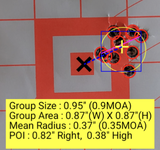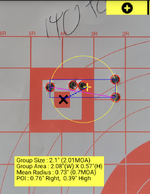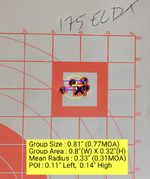NorthIdahoDude
WKR
- Joined
- Aug 29, 2022
- Messages
- 344
Not too long ago, I ran across a box of 140 Sierra Tipped Game Kings for the first time. I brought some home to try, and the first 10 round group in 7x57 was 0.8 MOA, with a Mean Radius of 0.25 MOA. For a redneck like me with a hunting rifle, that's pretty damn good.
A few days later, I ran across a close out special on them for what worked out to $0.24 a bullet. For a pretty accurate, high BC bullet, that I would be comfortable hunting with, that seemed like a no-brainer, so I grabbed 1k of them without a second thought.
The more I shoot them however, I keep getting flyers, and horizontally strung groups... And accuracy in the 1.6MOA range. Damnit, is this my punishment for using a small sample size to decide a bullet was pretty accurate?
I was loading up another batch today, and just for grins, did an OAL check on 10 rounds... Varied by as much as .010. WTH? Grab the comparator, and the case head to ogive measurements actually are pretty consistent...
So I grabbed 10 random bullets out of the box I had been loading from. Again, 0.010 variance in length. The base to ogive measurements again ran pretty consistent, but flipping the bullet and measuring the boat tail with the comparator again shows 0.010 variance.
So what say you guys, does that sound like maybe my root cause for weird flyers and group stringing? And does that sound like enough variance I should get on the phone with Sierra and ask for a replacements?
A few days later, I ran across a close out special on them for what worked out to $0.24 a bullet. For a pretty accurate, high BC bullet, that I would be comfortable hunting with, that seemed like a no-brainer, so I grabbed 1k of them without a second thought.
The more I shoot them however, I keep getting flyers, and horizontally strung groups... And accuracy in the 1.6MOA range. Damnit, is this my punishment for using a small sample size to decide a bullet was pretty accurate?
I was loading up another batch today, and just for grins, did an OAL check on 10 rounds... Varied by as much as .010. WTH? Grab the comparator, and the case head to ogive measurements actually are pretty consistent...
So I grabbed 10 random bullets out of the box I had been loading from. Again, 0.010 variance in length. The base to ogive measurements again ran pretty consistent, but flipping the bullet and measuring the boat tail with the comparator again shows 0.010 variance.
So what say you guys, does that sound like maybe my root cause for weird flyers and group stringing? And does that sound like enough variance I should get on the phone with Sierra and ask for a replacements?



